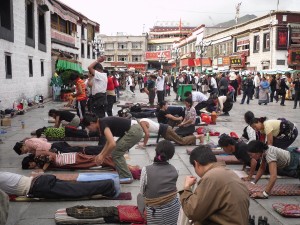
The following is an excerpt from a teaching by Jetsunma Ahkon Lhamo called “Art of Dispelling Anger”
For most of us, when we are wrathful or angry, it’s not wrathful. It’s not righteous wrath, you know, in order to help that person. The only time I can see where it would be useful for an ordinary person to be wrathful would be to maybe encourage somebody else to stand on their own two feet or to be less dependent or something like that. Now look, I really want you to do that, and you can talk sternly. But otherwise, where in your life should hatred be? Hatred is one of the three things that binds you to this world of samsara in which you will get old, you will get sick and you will die. And so we are taught that we must handle this hatred.
So when we approach hatred and look at it, we have to really examine our habitual tendencies. We can’t just say, you know, ‘I’m not going to hate anybody,’ or it’s kind of like a recovering alcoholic. It’s difficult, very difficult, to just say, ‘I’m not going to drink anymore. I’m going to use will power and I’m not going to drink anymore.’ You know, they say some people can do that, but most people can’t. And why is that? Because you have to learn about yourself. Because there is a reason why you drank in the first place. Because you have to learn to look inside of yourself and see what’s in there and you have to work it. What do they say in the program? ‘It works if you work it.’ What do I say about Buddhism? ‘It works if you work it.’ It’s the same deal. We are addicted to our habitual tendencies like a bunch of alcoholics. That’s why I love recovering alcoholics, because I feel such a kinship with them. And it’s beautiful that it’s so obvious to them that they are recovering addicts. Those of us who maybe have a little shot every now and then or whatever, a little wine every now and then or we’re teetotalers, we think, ‘Oh well, I’m not an addict. Oh, I’m pure, because I take vitamins and I eat bananas,’ and whatever.
But I tell you what. It’s that recognition that from the point of view of recovering from the addiction to the five poisons and from that awakening to Buddhahood, most of us are still at the stage where we are living like bag ladies and men under the bridge, because we ain’t recovered yet. We still have our hatreds; we still have our resentments. And we practice them.
When a Buddhist approaches ridding themselves of hatred, it can’t be done through willpower. It must be done through understanding, through practicing and ultimately through attaining view. Understanding means looking within oneself with honesty. None of us have been perfect. We’ve hurt others. We’ve killed bugs, people; I don’t know what, swatted flies, whatever. None of us has been perfect. And when we approach that, we need to look at that without excuses, bald-faced, you know? Where have I fallen down here?
Now we don’t want to look at in a harsh and miserable way. When I say take oneself to task, I mean have a long, sobering talk with oneself. I don’t mean self-hatred. That is useless and I don’t like it. I don’t want to see it. I don’t want to talk about it; and I will slap you next week if I see it, because you are just as worthy as anyone else, and that’s just a game. When we get into self-hatred, it’s because we have bad qualities and we don’t want to deal with them. So I say, accomplish those qualities and your image of yourself will rise up like a mountain.
Most people that have poor self-image are stuck in a kind of fearful narcissism where they do not respect or understand what is outside. They do not respect or understand what is inside. They can’t tell the difference between outside and inside. And they are so internally focused, focused on their own needs, wants and dramas, particularly dramas, that it is really very difficult for these people to step out of their shell, their shell of narcissism, and begin to truly try to be of benefit to others. This narcissism, this kind of fearful self-absorption, often is one of the causes of a kind of hatred. If you are fearful and self-absorbed in your own drama, it’s really, ultimately when you trace it down, pretty much all about you. You know? If you have that kind of thing, there is never the opportunity to understand the nature of phenomena. There is never the opportunity to understand the primordial naturally luminous wisdom state that is our nature because of the drama. And there is even a posture with that. Forthe people who have that kind of thing, as they grow older, their body tends to go like that. It caves in like that. And it’s the protecting that we’re doing of something that we feel is inherently real–ego.
When you think, ‘Oh, what can I do about this? I’m so fearful. Of course she’s saying I’m narcissistic, but it’s really that I am afraid.’ Well, what can we do about that? I think one step is to notice that are there are other people who are afraid, also. Notice that everybody is afraid. Notice that there is a humanity that we share of brother-sisterhood, a humanness that we share, human experiences that we will all have together. We will grow old. We will be sick. We will die. This is the condition that humanity shares in samsara. So learn to recognize in others that connection, even if it’s a sad one, that we all suffer the same; and we have the same wants, too. That narcissistic self-absorbed person who is very fearful wants desperately to be happy but doesn’t know how. And so in order to make themselves better, they stay frozen. They have hatreds and fears toward everybody else. And that’s the reaction.
Copyright © Jetsunma Ahkon Norbu Lhamo All rights reserved







